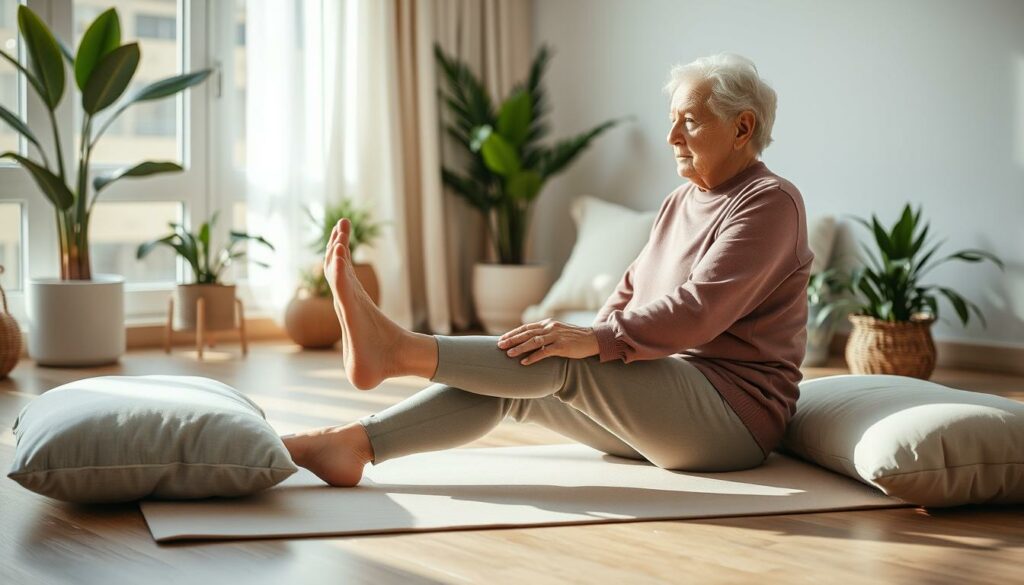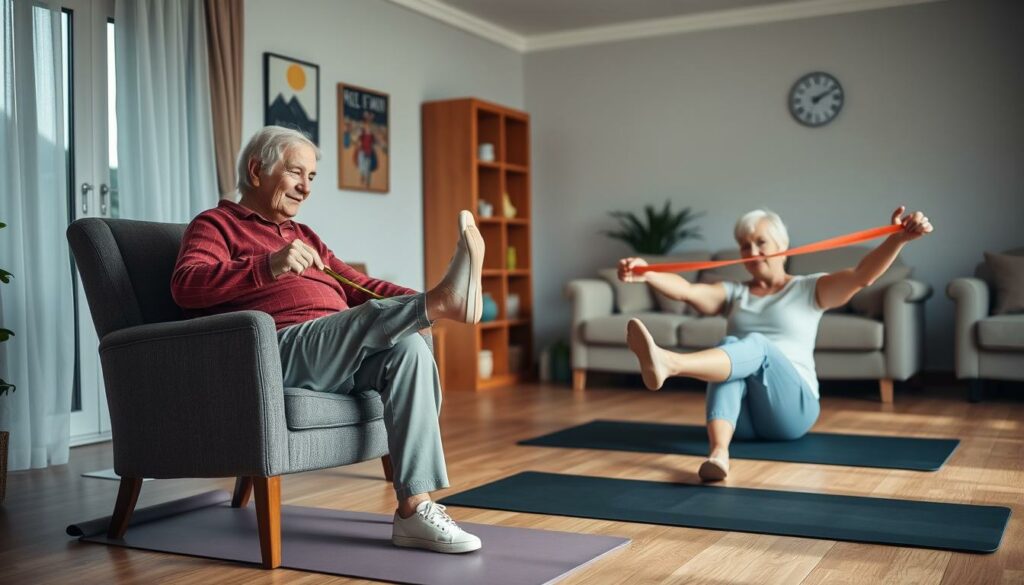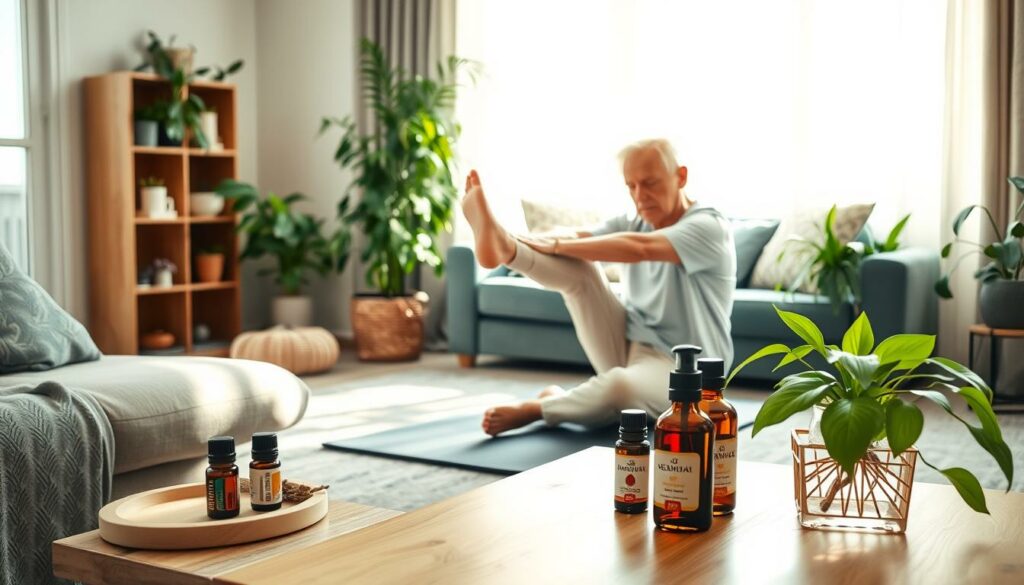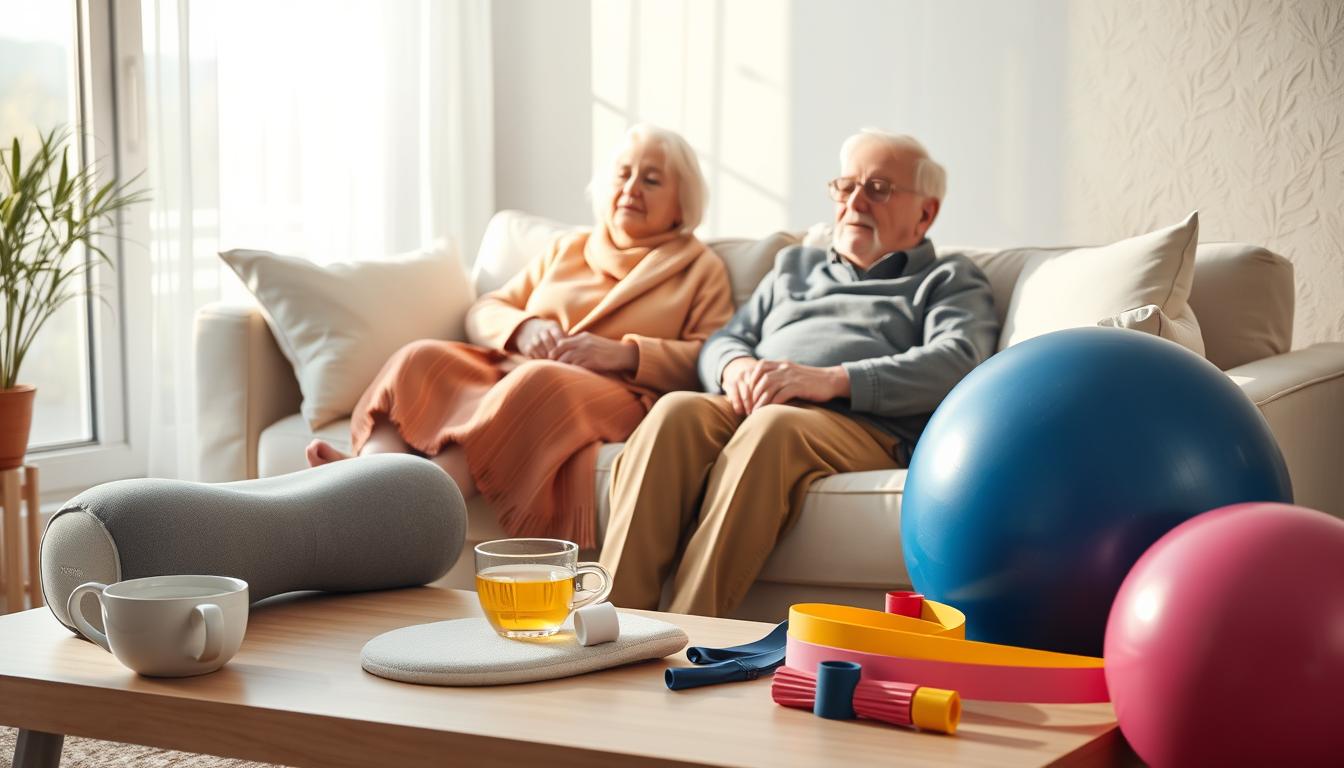Did you know nearly 50% of seniors deal with knee pain? This fact shows how important it is to tackle knee discomfort. It can really affect how well seniors move and enjoy their lives. Finding good ways to ease knee pain is key for seniors to stay active.
By looking into different treatments and ways to manage pain, you can help seniors feel better. This way, they can enjoy their daily activities without pain.
Key Takeaways
- Knee pain is common among seniors, affecting their ability to move.
- Knowing why knee pain happens is the first step to feeling better.
- Keeping a healthy weight is important for managing knee pain in seniors.
- There are many non-surgical ways to ease knee pain.
- Regular exercise can make knees more flexible and less painful.
- Natural remedies and holistic methods can help along with traditional treatments.
Understanding Knee Pain in Older Adults
Knee pain is common among older adults. It affects daily life and quality of life. Knowing what causes knee pain helps manage it better.
Common Causes of Knee Pain
As you age, knee pain becomes more likely. This is due to injuries or wear and tear. The main reasons for knee pain include:
- Osteoarthritis: This disease breaks down cartilage, causing pain and stiffness.
- Cartilage tears: Damage to cartilage can happen, mainly in active people.
- Ligament strain: Injuries to ligaments, like the ACL, are common in sports.
- Tendonitis: Inflammation from repetitive stress on the knee.
- Other medical conditions: Conditions like rheumatoid arthritis and gout can also cause pain.
Symptoms of Knee Osteoarthritis
Knowing the symptoms of knee osteoarthritis is key. Common signs include:
- Joint pain: A constant ache in the knee, worse with activity.
- Swelling: Inflammation around the knee, causing swelling.
- Stiffness: Feeling tight, mainly after not moving for a while.
- Reduced mobility: Trouble bending, straightening, or using the knee, making daily tasks hard.
Understanding these symptoms helps you get the right treatment and make lifestyle changes for better knee health.
| Cause of Knee Pain | Description |
|---|---|
| Osteoarthritis | The most common type of arthritis affecting the knee, caused by cartilage wear. |
| Cartilage Tears | Injuries that lead to damage in the knee’s cartilage, often due to physical activity. |
| Ligament Strain | Injuries occurring during high-impact sports involving sudden movements. |
| Tendonitis | Inflammation of the tendons due to repetitive strain on the knee. |
| Other Medical Conditions | Can include rheumatoid arthritis and gout, leading to additional knee pain. |
Importance of Weight Management for Knee Health

Managing your weight is key to keeping your knees healthy. Too much weight puts extra stress on your knees, which is bad for those with knee pain. Learning how weight affects knee pain is a big step towards feeling better.
By eating healthy, seniors can reduce knee pain and move more easily. This is a big win for knee health.
Impact of Excess Weight on Knee Pain
Being just 10 pounds overweight can add 30-60 pounds of pressure on your knees with each step. This can lead to knee osteoarthritis (OA). Women who are overweight are nearly four times more likely to get knee OA, and men are five times more likely.
Studies show that losing weight can really help with knee OA pain. This is a big reason to manage your weight.
Healthy Eating Habits
Eating well is vital for losing weight and staying healthy. A diet full of fruits, veggies, whole grains, and lean proteins helps. Here are some tips for eating better:
- Eat a variety of colorful fruits and vegetables.
- Choose whole grains over refined ones.
- Go for lean proteins like fish, beans, and poultry.
- Avoid foods high in sugar and unhealthy fats.
- Drink water instead of sugary drinks.
Controlling portions and eating mindfully also helps with weight loss. Losing just one pound can take four pounds off your knees. This shows how weight loss helps with joint pain. Eating well is a big step towards better knee health and less pain.
| Weight Loss (lbs) | Pressure Relief on Knees (lbs) | Reduced Risk of Knee OA |
|---|---|---|
| 1 | 4 | Minimal |
| 10 | 40 | Significant |
| 11 | 44 | Over 50% |
| 21.5 | 86 | Substantial |
| 33 | 132 | Very High |
Knee Pain Relief for Seniors

Knee pain is common in older adults. There are many non-surgical ways to help. These options can make a big difference in comfort and movement.
Non-Surgical Treatment Options
There are several non-surgical ways to ease knee pain. Physical therapy is a top choice. It includes exercises to strengthen the muscles around the knee.
This strength helps stabilize the knee and lessen pain. Exercises are also key in helping seniors with knee pain.
- Cortisone injections can quickly ease pain by targeting inflammation in the knee.
- Hyaluronic acid injections make the joint more lubricated. This reduces pain and improves movement.
- Bracing supports the knee and takes pressure off sore spots.
Medication Management for Knee Pain
Managing knee pain with medication is also important. Over-the-counter NSAIDs like ibuprofen and naproxen can help right away. They reduce pain and swelling.
If pain is severe, doctors might prescribe stronger drugs. Talking to a healthcare provider helps create a treatment plan just for you.
Using these methods can greatly improve life for seniors with knee pain. Always talk to a healthcare provider before starting any new treatment. This ensures it’s safe and works well for you.
Exercises for Elderly Knee Pain Relief

Regular physical activity is key to easing knee pain for seniors. Adding specific exercises to your routine can offer a lot of relief. Low-impact activities are best for strengthening knee muscles, improving mobility, and keeping joints healthy.
Types of Exercises to Consider
Several exercises are great for easing knee pain in the elderly:
- Walking: A gentle yet effective form of exercise that helps strengthen leg muscles, improve posture, and boost flexibility.
- Swimming and Water Aerobics: These activities reduce weight on painful joints, making them excellent choices for joint health.
- Stationary Biking: Using a recumbent exercise bike provides a low-impact way to enhance knee joint health while minimizing discomfort.
For beginners, start with 10 minutes every other day. Gradually increase to 30 minutes daily. This gradual increase can help manage knee pain effectively.
Physical Therapy for Improved Mobility
Working with a physical therapist can greatly improve your mobility and reduce pain. They create a personalized program to build strength and flexibility. Many people see up to a 68% pain reduction in 12 weeks.
Physical therapy often includes:
- Guided exercises to strengthen surrounding muscles.
- Techniques to ensure safe and correct movement patterns.
- Advice on balancing exercise with minimal pain while keeping activities enjoyable.
Drinking enough water and eating a balanced diet can also help manage knee pain. Proper hydration and increased fiber intake may reduce joint inflammation, leading to better mobility. Always listen to your body and seek medical advice if you feel pain during exercise.
| Exercise Type | Benefits |
|---|---|
| Walking | Strengthens leg muscles, improves posture, boosts flexibility |
| Swimming | Takes weight off painful joints, promotes muscle strengthening |
| Stationary Biking | Gentle option for knee joint health, reduces discomfort during activity |
These exercises not only help manage knee pain but also promote a healthier, more active lifestyle.
Tips for Reducing Knee Pain in Seniors

Managing knee pain in seniors needs a mix of good posture, support, and home tips. These tips can make you feel more comfortable and mobile.
Posture and Support Recommendations
Keeping the right posture is key to lessening knee pain. Here are some posture and support recommendations to try:
- Choose chairs with good back support and a cushion to ease knee pressure.
- Wear shoes with strong arch support and cushioning. Steer clear of high heels or flat shoes.
- Change positions often when sitting for long to avoid stiffness and pain.
- Use a knee brace for stability and alignment during walking or activities.
- Do exercises to strengthen the muscles around your knees for better support and pain relief.
Rest, Ice, Heat, Compression, and Elevation (R.I.C.E)
The R.I.C.E method is great for managing knee pain and injuries. Follow these steps for the best results in R.I.C.E for knee pain management:
- Rest: Take breaks to avoid knee stress, mainly after being active.
- Ice: Use ice packs on the affected area for 15-20 minutes several times a day to lessen swelling.
- Compression: Use elastic bandages or compression wraps to control swelling and offer support.
- Elevation: Raise your leg above heart level when resting to help reduce swelling.
Natural Remedies for Knee Pain in Older Adults

Looking into natural ways to ease knee pain in older adults can be very helpful. Heat and cold therapy, along with aromatherapy, are two effective methods. Each one has its own benefits that can help with pain and improve movement.
Effectiveness of Heat and Cold Therapy
Using heat or cold on the knee can help with pain and swelling. Heat therapy relaxes muscles and boosts blood flow, aiding in healing. On the other hand, cold therapy cuts down on swelling and pain, giving quick relief. Using both can help older adults manage knee pain every day.
Aromatherapy and Essential Oils
Aromatherapy for knee pain offers a calming and natural way to help. Essential oils like ginger and cinnamon have shown to ease knee pain and improve joint movement. Studies suggest these natural remedies can work well with traditional treatments. Always talk to your doctor before trying new herbal remedies or essential oils for pain.
| Therapy Method | Benefits | Suggested Use |
|---|---|---|
| Heat Therapy | Relaxes muscles and increases blood flow | Apply for 15-20 minutes before activity |
| Cold Therapy | Reduces inflammation and numbs pain | Apply for 15-20 minutes after activity |
| Aromatherapy (Ginger Oil) | Supports pain relief and reduces stiffness | Inhale or apply diluted to the affected area |
| Aromatherapy (Cinnamon Oil) | Improves joint function and reduces pain | Inhale or apply diluted to the affected area |
Senior-Friendly Knee Pain Treatments

Knee pain, often caused by osteoarthritis, can make it hard for seniors to move around. It’s important to find treatments that work well for older adults. Acupuncture is a great option for easing knee pain and improving how well the knee works.
Acupuncture as a Pain Management Option
Acupuncture uses thin needles at certain body points to help heal and reduce pain. Studies show it can help with knee pain from osteoarthritis. Many seniors say they feel less pain and can move better after getting acupuncture.
This treatment not only eases pain but also makes the knee joint work better. It lets many older adults do more in their daily lives.
Role of Assistive Devices
Assistive devices help seniors stay independent while dealing with knee pain. These include:
- Supportive braces and sleeves: These come in different levels of support and are comfortable to wear.
- Mobility aids: Canes, walking sticks, and knee scooters help with balance and make moving easier.
- Cushioning products: Knee pads, cushions, and gel inserts add comfort and protection, helping with impact during activities.
Using assistive devices daily can greatly improve your life. It lets you do things more comfortably and safely. Combining acupuncture with assistive devices is a good way to treat knee pain in seniors.
Holistic Approaches to Senior Knee Pain Relief

Knee pain is a big issue for many older adults, often caused by osteoarthritis. Using holistic methods can help you find relief and move better. Meditative exercises and other therapies are good options to try.
Meditative Exercises like Tai Chi
Tai Chi is great for knee pain because it’s gentle and improves balance and flexibility. It’s based on slow movements and deep breathing. Studies show it can make muscles stronger, improve knee function, and reduce pain.
Alternative Therapies to Consider
Look into different ways to manage knee pain. Acupuncture is known to help by using needles to stimulate pain relief. Turmeric and ginger are also helpful because they fight inflammation and help you move better.
Conclusion
Understanding and managing knee pain is key for older adults to keep living well. About 25% of people over 55 deal with knee pain all the time. This shows how important it is to find ways to ease knee pain for seniors.
By making lifestyle changes, you can move better and feel more comfortable. Activities that keep you moving, along with natural remedies and chiropractic care, help a lot. They can make your joints work better and ease pain.
Many older adults face knee osteoarthritis, but surgery isn’t always needed. Tailored treatment plans that include exercise and diet are very helpful. Staying active helps avoid putting too much pressure on your knees, keeping them healthy.
Looking at knee pain from all angles is important. This includes physical care, emotional support, and learning about your condition. By focusing on your health and using the resources available, you can find relief from knee pain. This improves your overall well-being.
** Our website contains affiliate links. This means if you click and make a purchase, we may receive a small commission. Don’t worry, there’s no extra cost to you. It’s a simple way you can support our mission to bring you quality content.
FAQ
What are the most common causes of knee pain in seniors?
Knee pain in older adults often comes from osteoarthritis, which wears down cartilage. It also stems from strained ligaments, cartilage tears, rheumatoid arthritis, and gout.
What symptoms should I look out for with knee osteoarthritis?
Signs of knee osteoarthritis include pain, swelling, stiffness, and less mobility. These symptoms can really impact your life quality.
How can maintaining a healthy weight benefit my knee health?
Keeping a healthy weight eases knee pain, which is key if you have osteoarthritis. Eating a diet full of fruits, veggies, and whole grains helps manage your weight.
What non-surgical treatment options are available for knee pain relief?
To ease knee pain, try physical therapy, strengthening exercises, and injections like cortisone and hyaluronic acid. Over-the-counter NSAIDs can also help manage pain.
What types of exercises are recommended for relieving knee pain in the elderly?
For elderly knee pain, low-impact exercises like walking, swimming, and biking are best. They strengthen knee muscles without adding strain.
What are some effective tips for reducing knee pain in seniors?
To lessen knee pain, maintain good posture, use supportive chairs and shoes, and apply the R.I.C.E method. This helps with knee injuries.
Can natural remedies effectively manage knee pain for older adults?
Yes, natural remedies like heat and cold therapy can reduce inflammation and pain. Aromatherapy with ginger and cinnamon essential oils can also help.
Are there senior-friendly treatments for knee pain that I should consider?
Acupuncture is a senior-friendly option for knee pain relief. It improves function and reduces pain. Using canes and knee supports also helps with mobility.
What holistic approaches can help with knee pain relief?
Holistic methods like Tai Chi enhance balance, flexibility, and joint health. Chiropractic care and herbal supplements can also support conventional treatments.


This article provides a helpful overview of knee pain causes and treatments for seniors. I appreciate the focus on non-surgical options, weight management, and low-impact exercises like swimming and walking.
From personal experience, my parents found relief through physical therapy, water aerobics, and even acupuncture. Supportive shoes and braces also made a big difference in their mobility.
I like that the article includes natural remedies like essential oils and Tai Chi, offering holistic options alongside traditional treatments. It’s a great resource for seniors or caregivers. Has anyone else tried these methods? What worked for you?
Hi Shawn,
Thank you for sharing your experience! It’s wonderful to hear how physical therapy, water aerobics, and acupuncture helped your parents find relief. Supportive shoes and braces can indeed make a world of difference in improving mobility and reducing discomfort.
I agree that combining holistic options like Tai Chi and essential oils with traditional treatments offers a well-rounded approach to managing knee pain. If anyone else has tried these or other methods, I’d love to hear what worked for you or your loved ones!
Let’s keep the conversation going and share more tips to help seniors maintain their mobility and quality of life.
Cheers
John